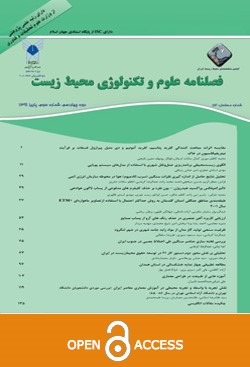مقایسه قابلیت برگ درختان برای ترسیب ذرات معلق هوا با تحلیل تصاویرمیکروسکوپ الکترونی
محورهای موضوعی : آلودگی هوا
سارا عباسی
1
![]() ,
سید محسن حسینی
2
,
نعمت اله خراسانی
3
,
عبدلرضا کرباسی
4
,
سید محسن حسینی
2
,
نعمت اله خراسانی
3
,
عبدلرضا کرباسی
4
1 - دانشجوی دکتری محیطزیست. دانشکده محیطزیست و انرژی. دانشگاه آزاد اسلامی واحد علوم و تحقیقات تهران. ایران.
2 - استاد گروه جنگلداری، دانشکده منابع طبیعی، دانشگاه تربیت مدرس. ایران. *(مسوول مکاتبات)
3 - استاد گروه محیط زیست دانشگاه تهران و دانشگاه علوم و تحقیقات
4 - دانشیار گروه محیط زیست. دانشکده محیط زیست دانشگاه تهران.
کلید واژه: میکروسکوپالکترونی روبشی, طیفسنجیپراشانرژیپرتوایکس, ذرات معلق هوا, آنالیز ذرات منفرد, مرفولوژی برگ,
چکیده مقاله :
زمینه و هدف: در مطالعه حاضر ویژگی ذرات ترسیب شده بر سطح برگ درختان گونههای چنار (Platanus orientalis)، نارون (Ulmus carpinifolia)، اقاقیا (Robinia pseudacasia)، توت (Morus alba) و زبان گنجشک (Fraxinus excelsior) در حاشیه یکی از خیابانهای پرتردد در تهران(محدوده میدان آزادی)با استفاده از تصاویر میکروسکوپ الکترونی و آشکارساز آنالیز عنصری (SEM-EDX) بررسی شد و قابلیت برگ گونههای درختی مختلف برای ترسیب ذرات مقایسه شد.روش بررسی : از هر گونه درختی یک پایه انتخاب شد. پایه های درختی سالم و در کنار یکدیگر در حاشیه یک خیابان پرترافیک قرار داشت. تاج پوشش درختان از یکیدیگر جدا بود. برگهای سالم از ارتفاع2 الی5/2 متری از سطح زمین از بیرونیترین قسمت تاجپوشش درختان در سمت خیابان چیده شد. برای تصویربرداری با میکروسکوپ الکترونی از سطوح برگ ها، نمونه ها در آزمایشگاه آماده سازی شد. بیش از 50 ذره با آنالیز آشکارساز عنصری بررسی شد. درصدجرمی عناصر هر ذره ثبت شد. قطر معادل برای هر ذرهای که توسطSEM-EDXتصویر آن تهیه شده بود، در نرم افزارImageJ بهصورت دستی اندازهگیری شد. از برگها با استفاده از اسکنر تصویر با فرمتJpg تهیه و با نرمافزارImagej مساحت برگها تعیین شد. وزن ذرات ترسیب شده بر برگ هر درخت نیز توزین شد.یافته ها : 21عنصر در ذرات شناسایی شد. بیش از 50 ذره آنالیز شد. عناصر کربن، اکسیژن، آهن، سیلیس بیشترین درصد جرمی و عناصر کربن، کلسیم، سیلیس، اکسیژن، آهن و پتاسیم بیشترین درصد حضور در ذرات را داشتند. ذرات با قطر کمتر از 5/2میکرومتر فراوانترین ذرات بودند. ذرات فلزی با قطر بین5/2تا10 میکرومتر فراوانترین ذرات فلزی بودند. قطر ذرات بهترتیب در چنار، توت، زبانگنجشک، اقاقیا، نارون بیشتر بود ولی مقایسه میانگین آماری قطرذرات ترسیب شده بر برگ درختان تفاوت آماری نشان نداد. این عدم تفاوت آماری ابعاد ذرات ترسیب شده بر برگها به دلیل یکسان بودن موقعیت قرارگیری پایه های درختان نسبت به منبع انتشار ذرات و مشابه بودن منابع انتشار ذرات است. بیشترین میزان ذرات ترسیب شده روی سطح برگ به ترتیب در چنار، نارون، زبان گنجشک، اقاقیا و توت بود.بحث و نتیجه گیری : مساحت برگ، وجود کرک، زبری سطح برگ، وجود موم، وجود رگبرگ، شکل برگ نقش موثری در تغییرات ویژگیهای ذرات انباشت شده بر سطح برگ درختان دارند.
Background and Objective: In this study, the characteristics of particles deposited on the surface of the leaves of species of Platanus orientalis, Ulmus carpinifolia, Robinia pseudacasia, Morus alba, and Fraxinus excelsior in the sideline of one of the crowded streets of Tehran (around Azadi Square) were investigated using scanning electron microscopy(SEM)and energy dispersive X-ray analysis.Method: A base was selected from each tree species. The tree bases were safe and next to each other on the sideline of a high-traffic street. The canopy of the trees was separated from each other. Healthy leaves were placed from a height of 2 to 2.5 meters above the ground surface from the outermost part of the canopy of trees on the street side. Samples were prepared in the laboratory for imaging with electron microscopy of the surfaces of leaves. More than 50 particles were investigated by elemental detector analysis. The mass percentage of the elements of each particle was recorded. The equivalent diameter for each particle that its image had been prepared by SEM-EDX was measured manually in ImageJ software. The leaves were prepared using an image scanner in Jpg format and the area of the leaves was determined by Image J software. The weight of the particles sequestrated on the leaves of each tree was also weighed.Findings: the weight of deposited particles was measured and the leaves' capability of different species of tress to deposit particles was compared. This study is one of the few ones on elemental analysis of individual particles in Iran and it is the first time that the deposited particles on the leaves of trees are studied through this method. Twenty-one elements were detected in particles. Carbon, Oxygen, Iron, and Silica had the highest mass frequency and Carbon, Calcium, Silica, Oxygen, Iron and Potassium had the highest percentage of presence in particles. Particles less than 2.5 micrometers in diameter were the most abundant ones. Metal particles with a diameter between 2.5 to10 micrometers were the most abundant metal particles that were observed. The mean comparison of the diameter of deposited particles on the leaves of tress showed no significant difference between them. Particles' diameter was higher in Platanus orientalis, Morus alba, Fraxinus excelsior, Robinia pseudacasia and Ulmus carpinifolia, respectively. The highest rate of deposited particles on the leaf surface belonged to Platanus orientalis, Ulmus carpinifolia, Fraxinus excelsior, Robinia pseudacasia and Morus alba, respectively.Discussion and Conclusion: Leaf area, cracks, leaf surface roughness, wax, veins, and leaf shape have an effective role in changing the properties of deposited particles on the surface of the trees' leaves.
_||_


